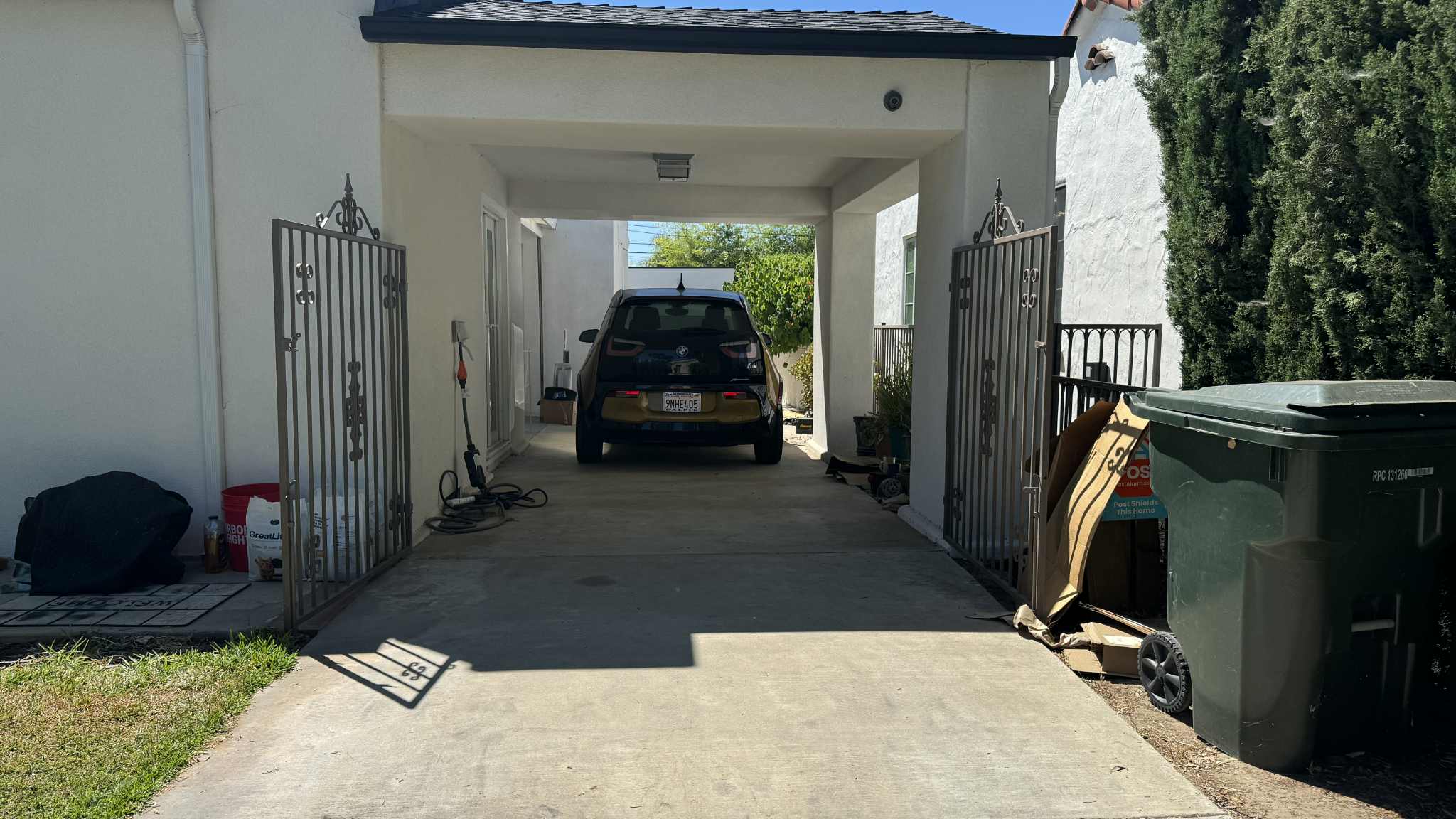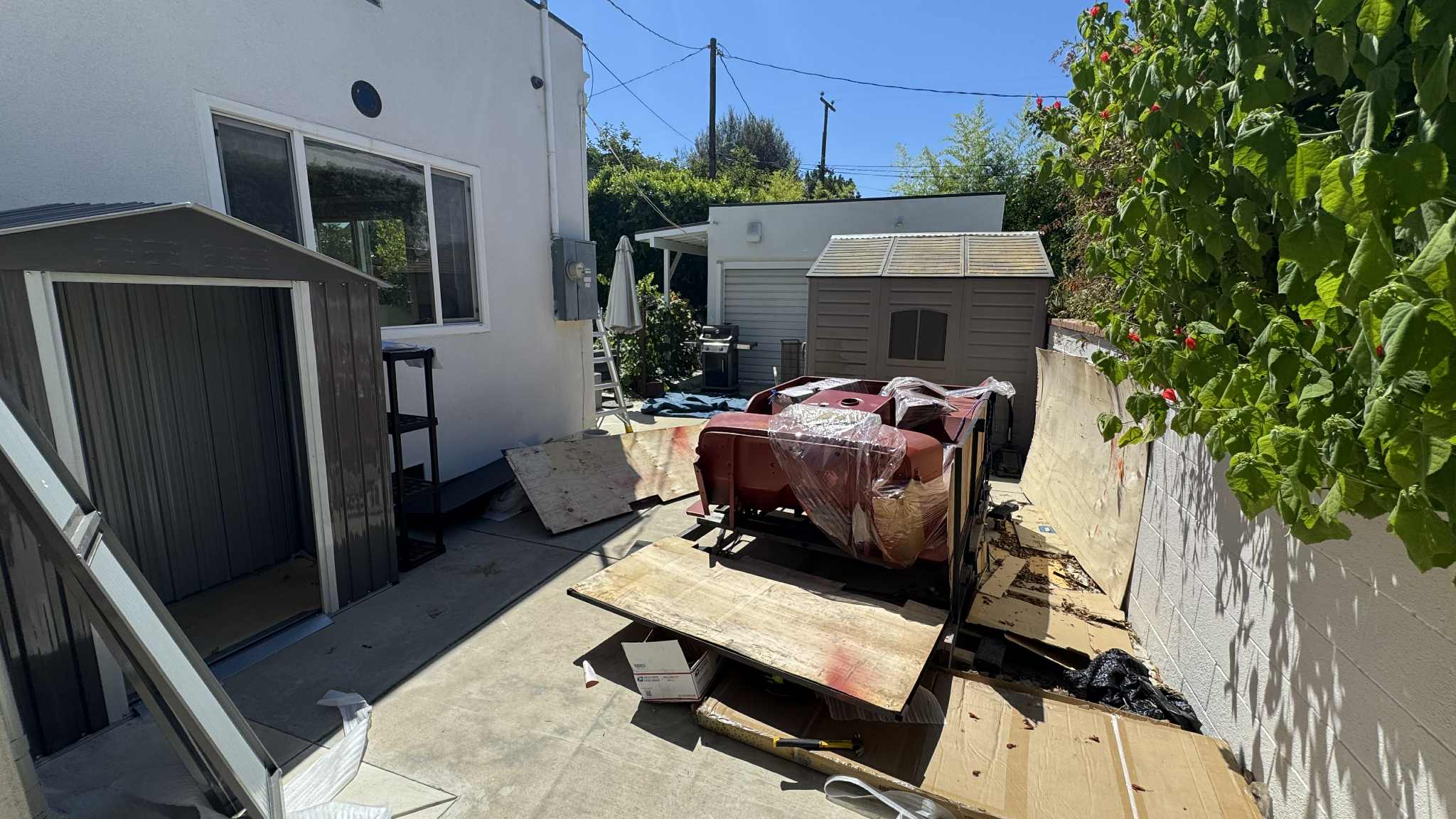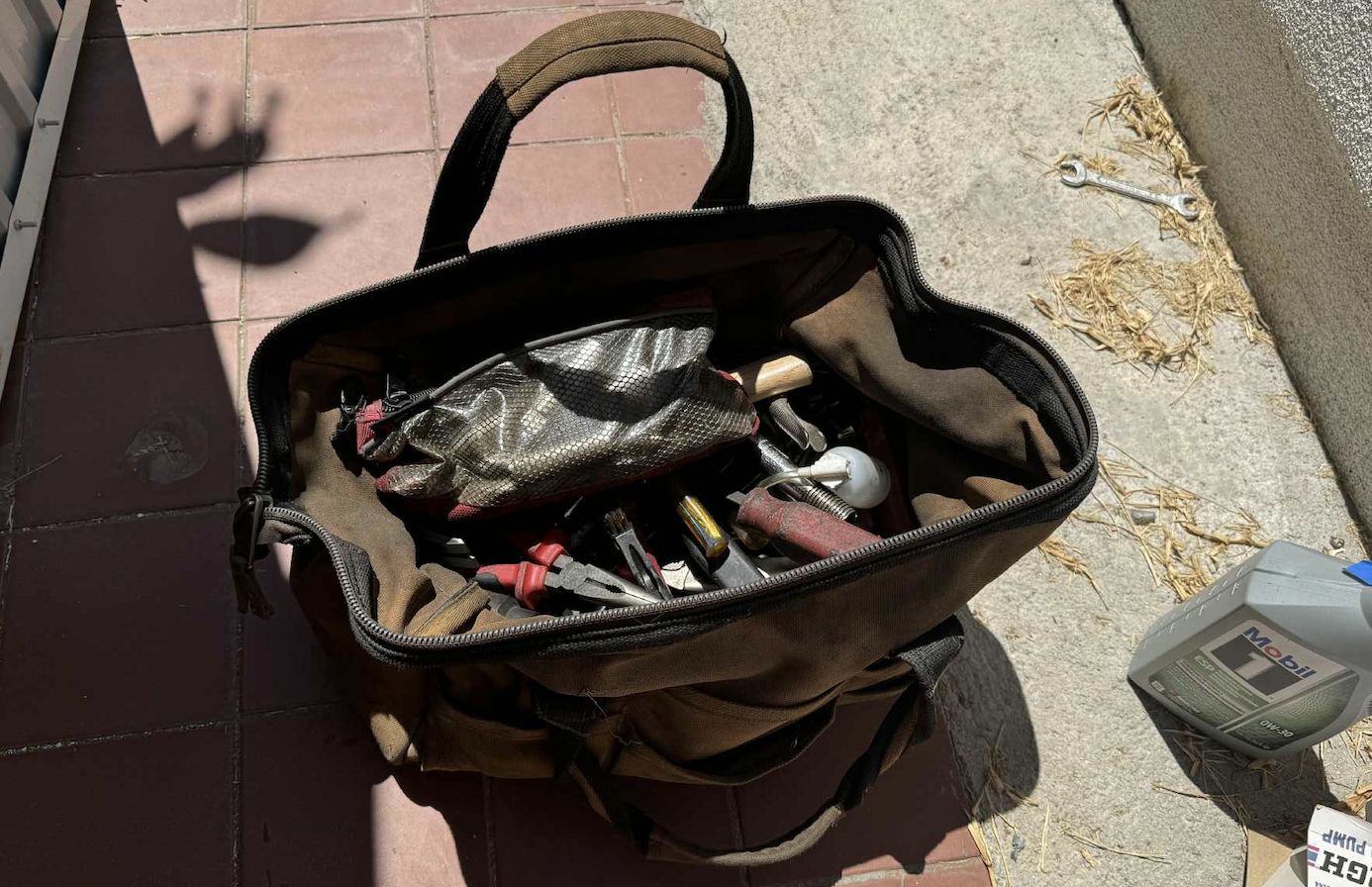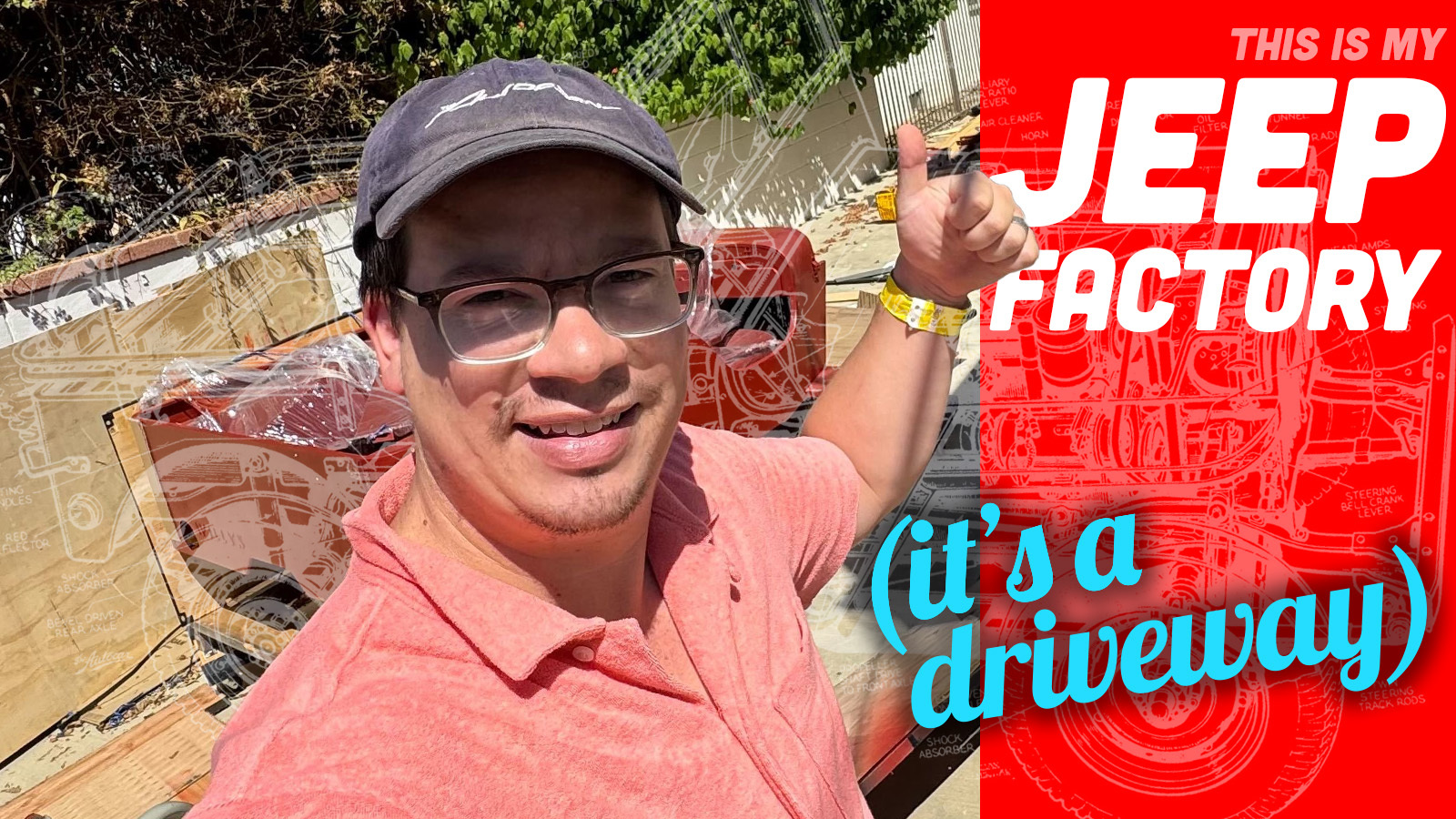As I recently announced: I have a massive project ahead of me. In a span of only seven months, I’m going to attempt to build a World War II Jeep from scratch using parts I’m buying from eBay. Yes, you read that right: from scratch. While I’ll get into the particulars of the build in my upcoming “build plan” article, today I want to show you where this project is actually going to take place: in my driveway.
Take a look at the footage under the reel below and you’ll see the Willys Overland factory in Toledo, Ohio, where an American icon is being built by hardworking men and women working as a team, using overhead hoists, spray booths, a moving assembly line, and all sorts of other specialized equipment to get allied soldiers the rough-and-tumble runabout they needed to fight for freedom.
At its peak, the Willys Overland factory was cranking out General Purpose (GP, from which the name “Jeep” is derived) vehicles at a rate of one every 5-ish minutes. By 1945, Willys Overland had produced over 350,000 “MBs,” while Ford — the other company contracted to build the Jeep, whose basic architecture had actually been developed by the small Butler, Pennsylvania-based company Bantam (which in the early 1940s was building British Austin 7s under license) — built 280,000 “GPWs.”
That’s right: Between 1941 and 1945, two companies cranked out roughly 650,000 MBs and GPWs, which were the designations for World War II Jeeps built by Willys-Overland and Ford, respectively, though they were largely identical. That’s around a Jeep every three minutes between the two companies. That haste builds upon American Bantam’s shockingly quick development period of just 49 days to design and build the first prototype.
So if a tiny Butler, PA-based company can develop an icon in only 49 days, and Willys and Ford could crank out a Jeep every 3 minutes, then surely I can build one in seven months, right?
I’m not so sure. You see, not only do I not have the personnel or specialized equipment, I also don’t have a factory. I have this driveway:


It’s skinny for the first 60 or so feet, then it widens a bit:

I’m grateful to have a driveway here in LA; it’s awesome, but it’s not a car factory by any stretch. It’s a fairly tight driveway that gets blisteringly hot pretty much year-round, and as far as equipment… I have a cherry picker and some hand tools.

I’m in the process of erecting a few sheds on my property, and I do have a giant one already in my driveway. I need to find a way to organize the hundreds of parts that will be rolling in from all over the world via eBay Motors (you can see the frame in the photo, as well as the body). With so many items coming in from various vendors, I could see this getting out of hand if I don’t have a solid system in place.


Though I do need space for the assembly, I may keep that giant shed that’s in my driveway solely for this project; it’s about 10 feet by 12 feet, and should fit everything I need. It’s currently filled with all sorts of junk:

I’ll buy some shelves, break out my labeling device, and break all the parts down into subsystems according to the official Chrysler designation, BICEEPR, which means:
- Body
- Interior
- Chassis
- Electrical
- Engine systems
- Powertrain
I’ll ignore the “R” for restraints, because the WWII Jeep didn’t have any.
I need to install some kind of sun shade above, so this is bearable, and I’ll need some lighting. This isn’t going to be like a typical car-media build — it’s not going to be in a fancy shop with a hydraulic lift and a bunch of expert technicians — it will be a dad and his friends in a driveway. Maybe I’ll tow the Jeep to a friend’s shop every now and then, but for the most part, it’s happening just outside my kitchen, in the blistering heat, between me changing my baby’s diaper and trying to edit blogs.
It’s a daunting one, and I welcome any input you, dear readers, may have on how I can best organize this driveway to handle the Jeep onslaught that lies ahead.









I for one am curious about what the real world cost of this project might wind up being. Any chance you’ll do a BOM with what they would cost to buy from eBay?
This a million times from me too. Personally I’d like to see a running total listing the parts and cost for each progress report and maybe an article that we can stash in the glove box which is essentially a spread sheet listing the parts and pricing at the time said parts were obtained.
Are we 100% on “General Purpose->GP->Jeep?” I’ve never heard anything conclusive.
This.
I am encouraged that it is the second comment.
Even Jeep (Canada) admits it isn’t 100% certain of the origin on their website.
“The most recognized says the name comes from the letters “GP”, the military abbreviation for “General Purpose”. However, some claim that the vehicle was named after a popular character named “Eugene The Jeep” from the Popeye comics.”
https://www.jeep.ca/en/articles/the-birth-of-the-jeep-name
Why not put up a sail shade or something?
Love this…and BTW, your wife is a saint! I get in trouble if I park the Morgan or the Alfa in the driveway for a few days!
Yeah, Elise (NHRN) is super accommodating. Since my wife became pregnant I haven’t attempted any “just for me” projects. Since my son was born I haven’t attempted any projects. Even basic maintenance is a massive PITA. Change the oil and rotate the tires? Nah. I’ll get a quick oil change done, get called away to take the baby off her hands, and not bother rotating the tires. It’s hard to even find a block of time big enough to mow the lawn without being interrupted.
It would be cool if you could have David Freiburger and/ or Rick Péwé to help out with this project. The whole build is pretty roadkill. It would an epic gathering of the minds.
I’d add Fred Williams to the list too. Seems like something he’d be down for.
Excellent addition.
Seconded and add Fred lime @stevenr says. Dirthead Dave?
So you won’t be installing the Strap, Safety, Assembly, WO-A-2883, or FM-GPW-1131414 on this one? It’s item AB:
https://a-so.de/wp-content/uploads/2024/03/armyshop-ohmenhausen-willysjeep-ersatzteile-front-compartment.jpg
Years ago I was reading up on some WWII history with regard to the Jeep and some of my sources were British; it was interesting to note how they mentioned that British soldiers had the nickname “GI-killer” for the Jeep because they had noticed how often drivers died from being impaled on the steering wheel column in head-on crashes that seemed otherwise survivable, severe injuries notwithstanding, so they weren’t as enthused about the Jeep as the Americans were.
And I came across references to the Italian market, black and otherwise, during the waning days of WWII and shortly thereafter where Italians would be salvaging various military vehicles left behind. Apparently the VW jeep was in such demand, due to its capabilities and ease of repair & maintenance, that the going rate was *two* U.S. Jeeps for one VW jeep; seems the Italians didn’t have a very high opinion of the U.S. Jeep, lol.
How Far away is El Monte from you? I bet CoGarage would probably like the free advertising and sponsor some garage space for you and the Crew in LA. https://www.cogarage.com/
Different if you can see the pieces strewn about outside your home’s window, haunting you, than needing to travel (even a few minutes) to a garage with easy access to all the tools, lifts, technical sources, etc. Visual motivation.
My guess is that David is trying to prove a ‘backyard mechanic’ doesn’t need more than a driveway, some fairly common tools, friends, understanding spouse, and time – plus mountains of optimism.
Wish him the best and will follow his wrenching, retching and success in the coming months.
If you were still single, you could assemble sections in the climate-controlled house. Could you use one of the sheds for assembly and instal a small window AC?
I’ve found vevor is extremely useful and they sell on eBay normally maybe can use your deal to get stuff from them or get a deal with vevor too. I would get a temporary garage tent or some kind and a portacool or portable ac, a good air compressor is very useful for many things. A dedicated shop vac might not be a bad thing especially if you have other projects going. Screw and hardware assortment is a huge time and money saver. If you figure out your order of operations and keep that in mind when stacking things it makes the project go smoother nothing worse then looking for one of the first things that came in under a mountain of other things and spending a few hours of what could be productive looking for it.
Can’t you use that giant shed behind your plastic shed? Can’t you use Galpin’s garage? 😛
Too bad he couldn’t have helped you find a place with a garage 🙁
Autopian people are probably specifically banned from the shop for insurance reasons, and I’m sure David has his reasons, discussed at length with Elise, why it can’t be on their lot.
I would think Elise NHRN is returning to work if she hasn’t already done so. So our intrepid Mr. Tracy is building this, this…thing, between child care and website managing.
I don’t think so, I’m pretty sure he mentioned that they offered space in the shop when he was wrenching on something in the parking lot. I would guess the reason they don’t ever use the Galpin shop is because “I did a project using a professional shop space and everything went smoothly” doesn’t make for interesting content.
What is in the garage at the end of the driveway?
This. Thats the place to build it. Also consult David Frieburger about building Jeeps in small LA garages.
DT: I don’t have a garage
Also DT: <shows several pictures prominently displaying what appears to be a multi-car garage at the end of his driveway>
We readers demand answers!
He addresses that in the video. The previous owner of the home made that an accessory dwelling unit. It is finished livable space (that he is using for storage), it is no longer usable as workspace for a car.
Sounds like priority one is to turn that space back into a garage!
As a car guy without enough garage space, I’ll agree. I’ll also acknowledge I’m not well versed in the LA housing market, but I assume reverting from ADU to garage will reduce property value. Spending money to reduce home value seems like a bad plan.
Depends on if the total cost (cost to revert plus net “loss” on the home value) is worth it to you personally. As a car guy who’s never owned a garage, I know I’d be willing to trade some of my homes value to have one…
I did not see any videos. All I see is “Click to accept marketing cookies and enable this content”
Yeah, I grumbled about that message after I got a new computer. Click Yes or whatever, and it didn’t appear for me again. (Shh don’t tell the ad folks that I am using an ad blocker and am a member).
I suspect it could become a garage again with enough of a run at it. Admittedly it’s trickier with that one shed where it is.
David had me at “labelmaker”.
Saw the first (uncrating) video. Hope it turns into a build series of videos.
Is this project a ‘bolt together’ or will you have to weld on it?
If the ordinance spooks don’t get you, I’m gonna move in next door and hang a 7.3 IDI over the fence.
BICEEPR – R = Every day is arm day.
Everything from ebay means a lot of cardboard to recycle. Hopefully you can take it to Galpin’s bin when yours fills.
I recycle all my cardboard, fear not!
I had no doubt. I am just sometimes amazed at how much cardboard is in my life all the time now.
But first save the large pieces for when you have to crawl under the car
Plenty of room in the J10 and the Chevy trucks!
The organized shed is a great idea, but do I not see a garage behind the big vinyl shed?
I believe that is full of his brother’s Mustang.
Could be. Weird choice to put a shed in front of the garage door, blocking vehicles from getting in or out of it, but definitely not the craziest choice our guy has made 🙂
This honestly looks like a lot of fun. I would invest in a shade structure and a portable swamp cooler. Makes life so much nicer.
Oh, a swamp cooler? Like a water-fed fan kind of thing?
They don’t work too bad in dry california air
Yeah, the idea is the evaporating water cools the air as it flows across a filter.
Yup! In sunny Arizona, it’s a life saver! Since CA is relatively dry, it will work great!
Are you just looking for ways to infuse rust into the build?
Whether you use a swamp cooler or just an window mounted AC unit type thing, if you get even a harbor freight or ebay “tent garage” with walls, then build a support for the AC/Swamp cooler through one of those walls, you might be very surprised how much impact they can have. The better your garage tent seals (fewer seams) the better it will work.
Yes, these typically have a water tank, which you can fill with a garden hose, on the bottom and pump the water through perforated pipes on top over some absorbent media (some look like really wide corrugated cardboard on edge) and a fan above the water tank pulls air through the wet media so the evaporative effect results in considerably cooler air. They work great in arid climates like what you have. The dry cleaning shop where I occasionally work in industrial maintenance (repairing the steam presses, D/C units, conveyors, fans, etc, etc) have two on casters that you can move around and they’re surprisingly effective despite the utterly beastly humidity of East Tennessee so you can bet one will indeed be effective where you live 🙂 Because of all the steam presses (despite being on the small side for a dry cleaner there’s a surprising number of those presses in a relatively cramped space) the dry cleaning shop gets ungodly hot in the spring & summer (though it’s nice & warm in the wintertime, lol, which is nice as East TN can indeed get quite frigid) so those swamp coolers are greatly appreciated.
I think they come in enough of a variety of sizes that you probably could find one to suit your needs. The aforementioned dry cleaning shop has one the size of a small-medium refrigerator and one the size of a large-medium refrigerator or even a small-large refrigerator (I recently had to replace my old refrigerator and had to do a lot of comparison shopping for a new one and the variety of sizes was a bit bewildering, lol.)
So good luck with finding good cooling strategies!
Also, when I lived in a small town just south of Sacramento where it would get brutally hot (there were multiple days of 110-115 degree weather during the five years I lived there) I found it immensely helpful to put up some sunscreen fabric on some bamboo poles and fasten the poles to the fence of my backyard to provide shade which made so much of a difference on account of the arid climate. I would just move the bamboo poles around for optimal shade. Yeah, shade is somehow surprisingly underrated!!
Again, good luck! 🙂
It’s September. It will be cool soon and you’ll be done before it’s hot again. Also, might rain at some point. I think an ebay carport of some sort would work great.
When I was a still a Military Brat – the 1950’s houses which were built for Base Housing in CA had swamp coolers on the roofs.
Yes – Rudimentary AC – not dissimilar to the misters folks use poolside in Palm Springs.
Tho you probably don’t want a mister when building a Jeep.
My tip: Harbor Freight sells portable garages (read tent) with closable front and rear panels for about $170. One of these would easily hold an MB. I used a ShelterLogic storage tent myself big enough to hold a car. It’s still standing 13 years, three hurricanes, and countless thunderstorms later, not to mention relentless heat. So, I can vouch for the stability of these types of shelters. And when you’re done, collapse them down and dispose of them, or store for future use.
This. As a person who’s worked on vehicles in direct sunlight in temperatures higher than those in LA, a temporary garage with a warehouse-sized swamp cooler will make the project possible and perhaps even enjoyable. Lighting will be easier, too, which will make filming the project much easier.
May also want to level the site with sand or decomposed granite and lay down some plywood to create a stable floor.
Prepping the site properly will take one day and cost maybe $500, but will likely shorten the project by weeks and improve the quality of the build and resulting site content.
If you want to screw anything down into the concrete, make sure you do it in the back out of sight of the street, because when you screw something down it becomes a code issue, and in general they do not like any kind of permanent canopy structures. Even hard canopies.
I concur on the recommendation of the Harbor Freight tent garage – though if you get much wind, a little added bracing with 1″ EMT and some 1-3/8″ chain link fence T-brackets makes a world of difference. On mine, I added a horizontal brace across at the top of the walls where each upright meets the roof portion, and added an X-brace at the back wall. Two bags of tube sand at each corner should do if you can’t anchor it to the concrete – but definitely two. Only one bag at each corner and the wind can still move the whole thing.
I know it feels like a daunting project, but it’s very much like eating an elephant – one bite at a time.
1] build the axles, brakes, suspension, and steering. Attach them to the frame, so you have a rolling chassis. Makes the rest much simpler.
2] build and install the drivetrain.
3] drop the tub on, then attach the front clip
4] everything else is details, and this is such a simple vehicle, there aren’t many.
The one burning question that I haven’t seen answered is… how the heck do you get a VIN and paperwork to register it when you’re done??
If I want to register it in CA initially, I can do so as either a “Modified” vehicle (i.e. if I have, say, a rusty old titled Willys MB and want to show California that I’m modifying it with a new frame and body and engine), or I can register it as a Specially Constructed vehicle. There are other options involving initially registering it in other states. Ideally, I’d like to register it as a Specially Constructed Vehicle here in CA, but we’ll see where this takes me. It’s no doubt a significant element of this whole thing.
Can you buy a junk jeep with a title?
Another one? Doesn’t he already have several? 🙂
Check on insurance prior to registering as Special Construction. Some companies won’t insure and others tack on a massive upcharge.
You essentially built a ute in Australia (With a little help from your friends). Import some Australians for this build.
Get Laurence on a plane ASAP! 🙂
Rubbermaid or similar totes. Further define by application (brakes front, brakes rear, engine top end, etc). Sheet on end for inventory list in each.
Most importantly….don’t turn a wrench on a damn thing until you are organized. If you don’t do first, and commit to keeping it that way, then you never will. It will look like Michigan all over, but with new parts this time….
This will be important: how close is the nearest auto parts store?
Whatever the ebay delivery time is.
1 mile.
If you need time to think about your life choices you could maybe even walk that. Or get a bike with a big basket on it.
I have an E-Bike, so it’s just a couple of minutes for me. I bring a big backpack.
You upgraded the Raleigh?
What model did you get?
E-bikes are such a great way to get around in an urban environment. The biggest hassle is having to repeatedly lock up all the theftworthy bits (frame, both wheels, and seat), but even in terms of time, it’s about on par with using a car but with the benefits of light exercise and cheap, clean transportation… especially with a belt drive. I have a ten-mile route that satisfies most all my needs from groceries to hardware, and at the end of it I still have enough battery left for next time.
Back in the sweaty chain-driven days I used a large backpack, but a rack with a set of easily detached panniers lowered my center of gravity for more comfort and safety. My left forearm bones are held together with plates and screws after I Pete Rose’d it over the handlebars with a heavy pack a quarter century ago. I should have had a rack then… and learned to curl up in a crash.
This would have been so much easier if you could still use your landlord’s back yard for this stuff
But then we wouldn’t be cheering David’s new life milestones! And the parts would already be getting lost amongst the clutter.
Winter wrenching in LA vs Michigan. I know which one I’d consider “easier”.
“I will be organizing by the BICEEPR” system –
Body and Chassis in the mud pit
Interior stuffed into the crashed Kia
Electrical under the non-running Cherokee Golden Eagle
Engine systems under the snow in the driveway by the spare 4.0 I6
Powertrain in the dishwasher”
Wait? The parts washer in the kitchen is for dishes? Dammit. No wonder my wife is pissed at me.
Good luck.